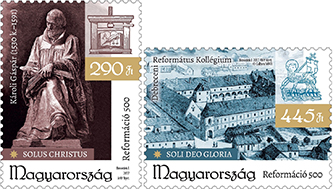
style="display:block"
data-ad-client="ca-pub-6935274628036882"
data-ad-slot="3184055459"
data-ad-format="auto">
1. Magyar - 500 éves a reformáció bélyeg
2. English - 500 years of the reformation stamp
1. Magyar - 500 éves a reformáció bélyeg
A Magyar Posta kétcímletű alkalmi bélyegsor és bélyegblokk kibocsátásával köszönti a reformáció 500 éves évfordulóját. A sor 200 000, a fekete sorszámmal ellátott blokk 60 000 példányban Benedek Imre grafikusművész tervei alapján az ANY Biztonsági Nyomda Nyrt.-ben készült. Az újdonság április 20-tól kapható.
style="display:block"
data-ad-client="ca-pub-6935274628036882"
data-ad-slot="3184055459"
data-ad-format="auto">
1517. október 31. – ez az az immáron történelmi dátum, amikor Luther Márton (Martin Luther) kitűzte 95 tételét a wittenbergi vártemplom kapujára, ami reformok sorozatát eredményezte nem csupán a keresztény vallás, hanem az élet minden területén. Luther fellépése átalakította Európa korabeli vallási térképét, megújította a hit világát, azonban az általa felállított hitelvek és gondolatok messze túlnyúlnak a teológia határain. Luther és a későbbi reformátorok, illetve a reformáció hatása a politika, a gazdaság, a zene, a jogtudomány, az anyanyelv és a modern természettudomány kibontakozása, illetve átalakulása terén is tetten érhető.
A magyarság különösen érintett a reformáció hatásai által, hiszen korunk történészi gondolkodása szerint, ha a Magyar Királyságra – mint Európa legkeletibb érintett területére – nem ér el a XVI. században ez a megújulás, akkor valószínűleg ma már nem a magyar nyelvet használnánk. Az ebben a korban három részre szakadt ország és a nemzeti újraegyesítő törekvések kedveztek a reformáció térhódításának a magyarság egésze körében. Az új vallás ettől kezdve a katolikus Habsburgok elnyomó politikájával szembeni nemzeti üggyé vált és nagymértékben hozzájárult a magyar nyelv és irodalom kora újkori látványos kibontakozásához is.
A félévezredes évforduló nem csupán Magyarországra vagy Európára korlátozódik, mert ma már szinte nincsen olyan ország a világban, ahol ne lennének a magukat a reformációból gyökereztető protestáns vallások jelen, a hívők száma jelenleg meghaladja a 800 millió főt.
Az alkalmi bélyegsor 290 Ft-os címletén az első magyar nyelvű bibliafordítás készítője, Károli Gáspár szobra és egy stilizált nyomdagép, illetve egy nyitott biblia látható – a kompozíciót a latin nyelvű „Solus Christus” (egyedül Krisztus) felirat egészít ki. A 445 Ft-os címleten a magyar reformáció egyik legfontosabb oktatási intézményének, a Debreceni Református Kollégium épületének 1802-es ábrázolása, illetve a Magyarországi Református Egyház címere jelenik meg, a grafika előterében a latin nyelvű „Soli Deo Gloria” (egyedül Istené a dicsőség) felirat olvasható. A blokk hátteréül az Evangélikus Országos Levéltárban őrzött kézírásos Luther-végrendelet és a wittenbergi vártemplom egy részlete szolgált, a grafika előterében az öt sola (a református hagyomány szerinti alapvető teológiai hitelvek) olvasható, a bélyeg pedig Luther Márton címere mellett egy XIX. századi színezett metszet alapján azt az ikonikus pillanatot ábrázolja, amikor felszögezi tételeit a wittenbergi vártemplom kapujára. A bélyegsor és a bélyegblokk első napi borítékjai azonos grafikával, az említett végrendeletből készített részlet ábrázolásával és az öt sola képi megjelenítését bemutató kompozícióval készültek el.
A reformáció nem pusztán a XVI. század emléke, hanem egy közös örökség mindannyiunknak, melynek nélkülözhetetlen eleme a folyamatos megújulás. emzetközi Úszószövetség logója, továbbá a sportágakra utaló szimbólumok láthatók, míg az elsőnapi bélyegzőt szintén a világbajnokság logója díszíti.
Forrás: Posta
style="display:block"
data-ad-client="ca-pub-6935274628036882"
data-ad-slot="3184055459"
data-ad-format="auto">
2. English - 500 years of the reformation stamp
Magyar Posta welcomes the 500th anniversary of the Reformation by issuing a two-denomination stamp set and a stamp block. The set has been produced in 200,000 copies, while the block with a black serial number in 60,000 copies by ANY Biztonsági Nyomda Nyrt. based on the artwork created by graphic artist Imre Benedek.
style="display:block"
data-ad-client="ca-pub-6935274628036882"
data-ad-slot="3184055459"
data-ad-format="auto">
31 October 1517 is the already historic date when Martin Luther pinned his Ninety-five Theses on the door of the Wittenberg Castle Church, which brought a series of reforms not only within the Christian religion, but also in all areas of life. While Luther's action transformed Europe's contemporary religious map and renewed the world of faith, the beliefs and ideas established by him reach far beyond the boundaries of theology. The impact Luther and the reformers later on as well as the Reformation had can be traced also in the emergence and transformation of politics, economics, music, law, mother tongue and modern science.
The Hungarians are particularly affected by the impacts of the Reformation since, according to the historians of our time, if in the 16th century this revival had failed not reach the Hungarian Kingdom - Europe's easternmost territory concerned, today we would probably not use the Hungarian language any more. In those times, the country divided into three parts and the national re-unification efforts favoured the spread of the Reformation among the whole Hungarian people. From then on the new religion became a national cause against the repressive policies of the Catholic Habsburgs, and greatly contributed to the spectacular early modern evolution of the Hungarian language and literature.
The half-millennial anniversary is not limited only to Hungary or Europe, as today there is almost no country in the world where one would not be able to find Protestant religions which trace themselves back to the Reformation, and the number of believers currently exceeds 800 million people.
The HUF 290 denomination of the commemorative stamp set shows the statue of Gáspár Károli who was first to translate the Bible into the Hungarian language and a stylized printing machine, as well as an open Bible. The composition also contains the Latin inscription of ‘Solus Christus’ (Christ alone). The HUF 445 denomination shows the building of one of the most important educational institutions of the Hungarian Reformation, the Reformed College of Debrecen from 1802, as well as the coat of arms of the Hungarian Reformed Church. At the forefront of the artwork is the Latin inscription of ‘Soli Deo Gloria’ (Glory to God alone). The background of the block shows Luther's handwritten will kept in the Evangelical National Archives and a detail of the Wittenberg Castle Church; in the foreground of the artwork the Five Solas (basic theological beliefs of the Reformed tradition) can be seen, while - in addition to Martin Luther’s coat of arms - based on a 19th century coloured engraving, the stamp depicts the iconic moment when Luther is pinning his Five Theses on the door of the Wittenberg Castle Church. The first day covers of the set of stamps and of the block of stamps have been produced with the same artwork, the detail of the said will and a composition of the pictorial representation of the Five Solas.
The Reformation is not only the reminiscence of the 16th century, but is a common heritage for all of us, an essential element of which is the ongoing renewal.
Source: Hungary Post


